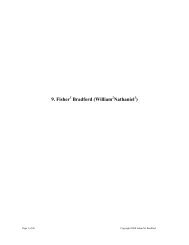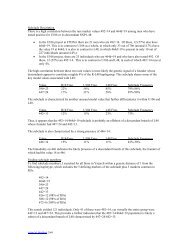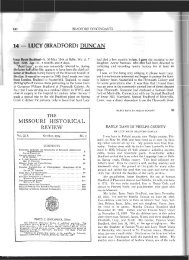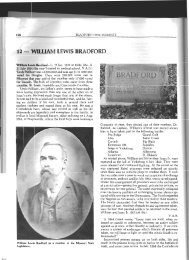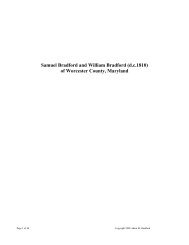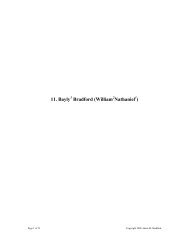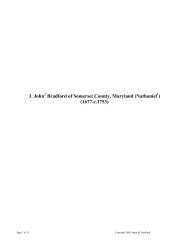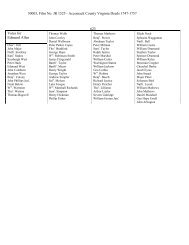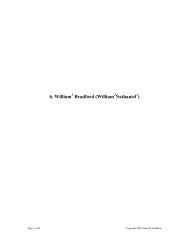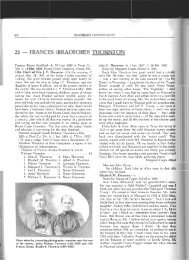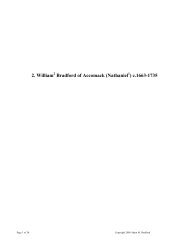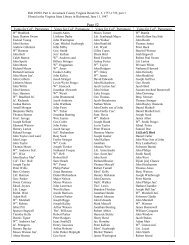1. Nathaniel Bradford of Accomack County, Virginia - Lower ...
1. Nathaniel Bradford of Accomack County, Virginia - Lower ...
1. Nathaniel Bradford of Accomack County, Virginia - Lower ...
Create successful ePaper yourself
Turn your PDF publications into a flip-book with our unique Google optimized e-Paper software.
Settlement <strong>of</strong> Sussex – <strong>Lower</strong> Delmarva Community<br />
It was not unusual for <strong>Nathaniel</strong> to have purchased land in what might seem at first to be an area rather far<br />
from his home plantation. In fact, numerous <strong>of</strong> the first settlers <strong>of</strong> Sussex were from the eastern shore <strong>of</strong><br />
<strong>Virginia</strong>. When the area was still held by the Dutch, it was a popular destination for runaway servants and<br />
slaves from farther south; and after the English took final control <strong>of</strong> the area in 1673, a good number <strong>of</strong><br />
those who began buying up large plots <strong>of</strong> land there were <strong>Accomack</strong> planters, or inhabitants <strong>of</strong> Somerset<br />
<strong>County</strong>, Maryland, itself settled largely by families whose ultimate origins lay in <strong>Accomack</strong>. Even as early<br />
as the late 1650s, in the first days <strong>of</strong> settlement in Somerset <strong>County</strong>, Maryland (just north <strong>of</strong> <strong>Accomack</strong>)<br />
one finds these same recent immigrants to Somerset pressing in upon the Dutch settlement around<br />
Rehobeth. However, it wasn’t until around 1677 that English settlement at Rehobeth really occurred in<br />
significant numbers, and <strong>Nathaniel</strong> was a part <strong>of</strong> this movement, although in his case it was not an actual<br />
movement but rather an expansion. Even though <strong>Nathaniel</strong> had a substantial plantation in Sussex, he never<br />
settled there himself. His Sussex estate was always <strong>of</strong> secondary importance when compared with his<br />
<strong>Accomack</strong> plantation.<br />
This movement <strong>of</strong> people from <strong>Accomack</strong> and Somerset into Sussex in the 1670s and 1680s was just the<br />
latest stage in a process <strong>of</strong> population movement that had been occurring since the earliest days <strong>of</strong><br />
settlement on the eastern shore, when there were just a few dozen people living in the south <strong>of</strong> the<br />
peninsula along Old Plantation Creek. Since then, there had been a steady movement <strong>of</strong> people northwards<br />
from the southern reaches <strong>of</strong> Northampton on up into what would become the new <strong>Accomack</strong> <strong>County</strong>, and<br />
farther north across the border into Somerset <strong>County</strong>, Maryland, and then even farther north into Sussex.<br />
It’s a fact that never fails to impress itself upon anyone who researches families in the lower Delmarva<br />
peninsula, this tide <strong>of</strong> northward settlement. In a way, the five counties which make up the lower Delmarva<br />
peninsula - <strong>Accomack</strong> and Northampton counties in <strong>Virginia</strong>, Somerset and Worcester counties in<br />
Maryland, and Sussex in Delaware – should be viewed as a single community, in that a large number,<br />
possibly even a majority, <strong>of</strong> the people who lived there shared a common heritage which ultimately had its<br />
roots in the eastern shore <strong>of</strong> <strong>Virginia</strong>. Despite being spread out over the administrative jurisdictions <strong>of</strong> three<br />
separate colonies, the inhabitants <strong>of</strong> lower Delmarva were <strong>of</strong>ten bound more closely to each other by ties <strong>of</strong><br />
community and kinship than they were to <strong>Virginia</strong>ns or Marylanders on the other side <strong>of</strong> the Chesapeake. 270<br />
* * * * *<br />
More Land Dealings<br />
In addition to his home plantation at Matchapungo and the 400 acres he patented in 1672, <strong>Nathaniel</strong><br />
purchased other tracts in <strong>Accomack</strong> <strong>County</strong> over the course <strong>of</strong> his life. In 1679, he took out a patent on a<br />
644-acre tract which formerly belonged to Hugh Yeo, but which had been deserted after Yeo’s intestate<br />
death. 271 <strong>Nathaniel</strong> soon lost his claim to this land: four years after his patent it came out that John<br />
Washbourne had received a patent for the same tract, and as a result both his and <strong>Nathaniel</strong>’s patents were<br />
voided. 272 In 1680, the year after patenting the former Yeo land, <strong>Nathaniel</strong> sold <strong>of</strong>f two plots <strong>of</strong> land he had<br />
purchased earlier. To Samuel Beech, <strong>Nathaniel</strong> sold the 400 acres he had patented in 1667 adjacent to his<br />
home plantation, and to John Willis he sold the 400 acres he had patented in 1672. 273 Though the original<br />
sales occurred in this year, neither sale was finalized until after <strong>Nathaniel</strong>’s death, when his son William<br />
completed the sales and they were finally recorded in <strong>Accomack</strong> Court. In 1681, the year after he sold the<br />
two plots to Beech and Willis, <strong>Nathaniel</strong> completed what would be his final land transaction when he<br />
purchased from William Jette another 500 acres in <strong>Accomack</strong>, this tract being located on the bay side <strong>of</strong> the<br />
peninsula on Pungoteague Creek. 274 These 500 acres along with the home plantation <strong>of</strong> 2400 acres and the<br />
plantation in Sussex passed to his son William after <strong>Nathaniel</strong>’s death.<br />
Page 48 <strong>of</strong> 74 Copyright 2008 Adam M. <strong>Bradford</strong>




